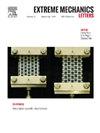Kinematic folding propagation in degree-4 origami strips
IF 4.5
3区 工程技术
Q2 MATERIALS SCIENCE, MULTIDISCIPLINARY
引用次数: 0
Abstract
Degree-4 origami strips, one-DOF mechanisms constructed by sequentially connecting degree-4 origami vertices, have inspired origami-based engineering design. However, thorough kinematic analyses were limited to a special subset of degree-4 origami strips that exhibit uniform folding along the sequence. In this study, we show how folding propagates non uniformly, i.e., gets attenuated or amplified, in a general degree-4 origami strip. We introduce the concept of kinematic folding propagation and analyze it by studying discrete dynamical systems. Our results reveal that, despite its simple structure, the strip exhibits diverse folding propagation behaviors, strongly influenced by design parameters such as sector angles and topology of the crease patterns. We show that the propagation behavior is topologically linear when adjacent vertices are connected via opposite creases. We compute and visualize folding motions, including strips that transition from a flat-folded state to a helical shape through uniform or nonuniform (attenuated/amplified) propagation upon actuation of the boundary crease. Additionally, we demonstrate folding propagation in physical models using 3D-printed prototypes with thick panels. Furthermore, we show that topologically nonlinear propagation emerges when adjacent creases are used to connect adjacent vertices. We also discuss folding propagation in curved-crease origami that is achieved by taking a continuum limit of the strip. Our findings establish kinematic folding propagation as a core functionality enabled by nonuniform folding, thereby laying the foundation for programmable origami.
4度折纸条的运动折叠传播
四度折纸条是一种由四度折纸顶点顺序连接而成的单自由度机构,它启发了基于折纸的工程设计。然而,彻底的运动学分析仅限于一个特殊的4度折纸条子集,它们沿序列呈现均匀的折叠。在本研究中,我们展示了在一般程度为4的折纸带中,折叠如何非均匀传播,即衰减或放大。引入了运动学折叠传播的概念,并通过对离散动力系统的研究对其进行了分析。我们的研究结果表明,尽管其结构简单,但该条带表现出多种折叠传播行为,这些行为受到扇形角和折痕图拓扑等设计参数的强烈影响。我们证明,当相邻顶点通过相反的折痕连接时,传播行为是拓扑线性的。我们计算和可视化折叠运动,包括在边界折痕驱动下通过均匀或不均匀(衰减/放大)传播从平折叠状态过渡到螺旋形状的条带。此外,我们使用带有厚面板的3d打印原型在物理模型中演示折叠传播。此外,我们证明了当相邻的折痕用于连接相邻的顶点时,拓扑非线性传播会出现。我们还讨论了弯曲折痕折纸中的折叠传播,这是通过取条带的连续极限来实现的。我们的研究结果将运动折叠传播作为非均匀折叠的核心功能,从而为可编程折纸奠定了基础。
本文章由计算机程序翻译,如有差异,请以英文原文为准。
求助全文
约1分钟内获得全文
求助全文
来源期刊

Extreme Mechanics Letters
Engineering-Mechanics of Materials
CiteScore
9.20
自引率
4.30%
发文量
179
审稿时长
45 days
期刊介绍:
Extreme Mechanics Letters (EML) enables rapid communication of research that highlights the role of mechanics in multi-disciplinary areas across materials science, physics, chemistry, biology, medicine and engineering. Emphasis is on the impact, depth and originality of new concepts, methods and observations at the forefront of applied sciences.
 求助内容:
求助内容: 应助结果提醒方式:
应助结果提醒方式:


